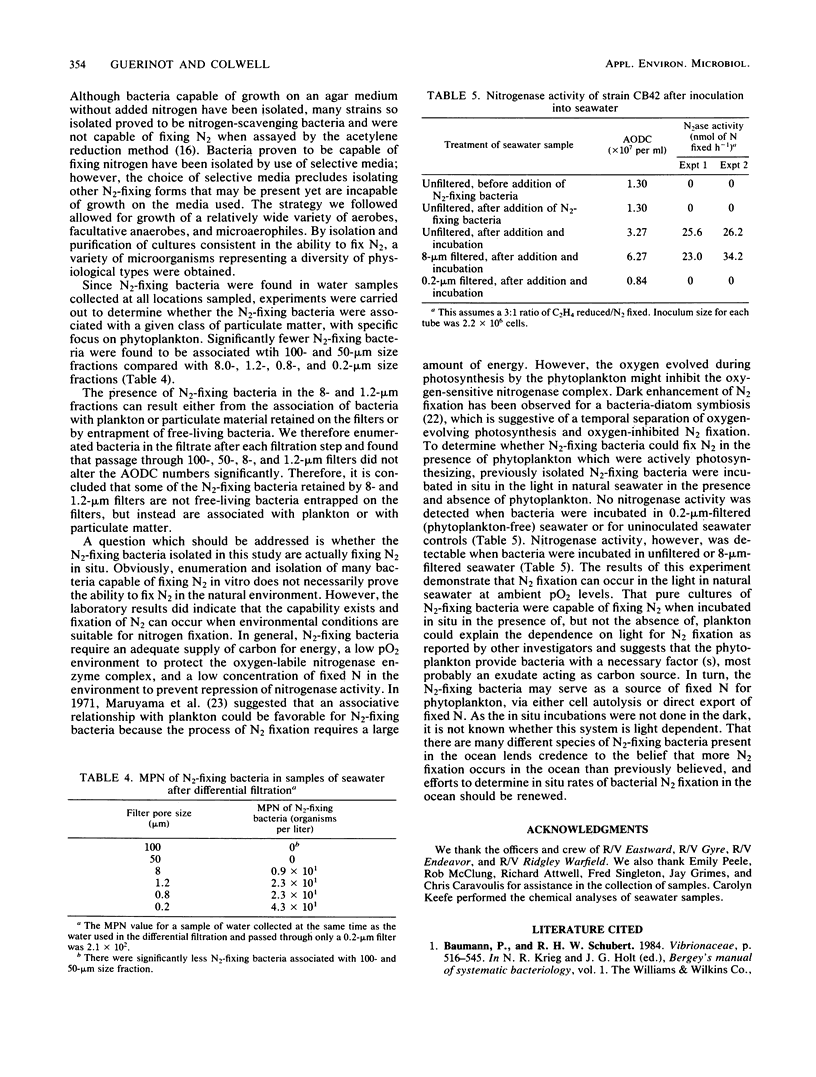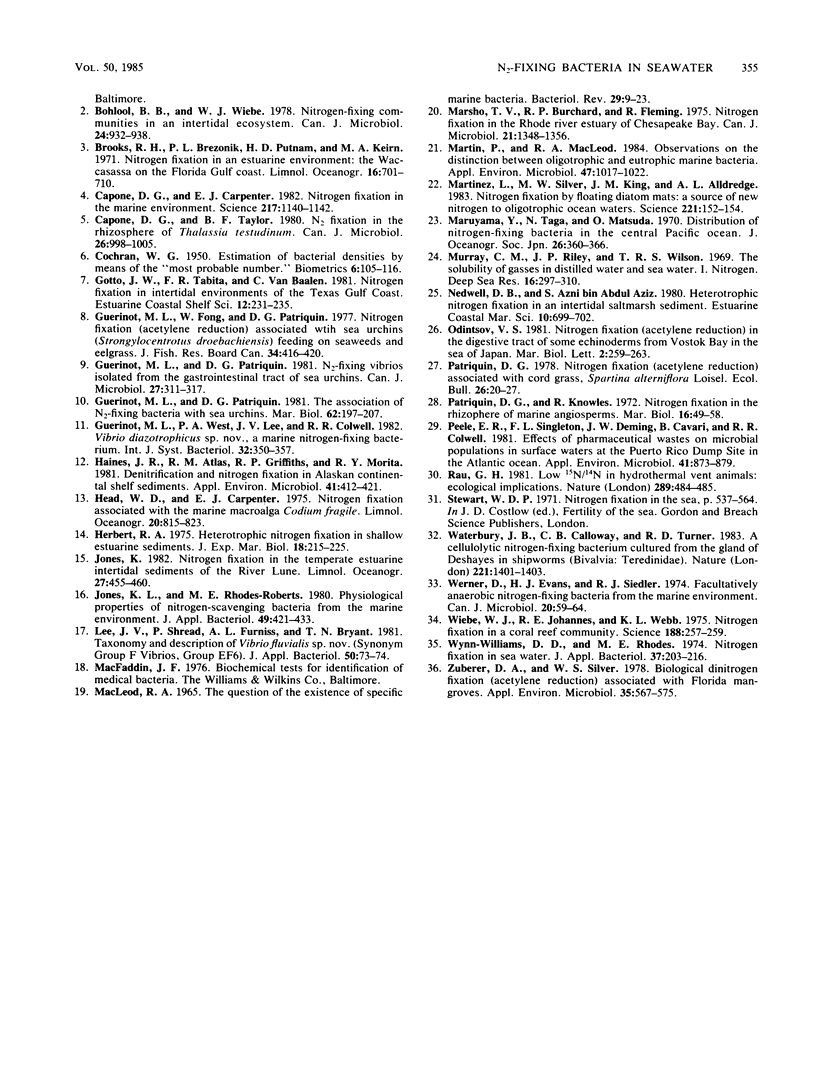Abstract
Marine pelagic N2-fixing bacteria have not, in general, been identified or quantified, since low or negligible rates of N2 fixation have been recorded for seawater when blue-green algae (cyanobacteria) are absent. In the study reported here, marine N2-fixing bacteria were found in all samples of seawater collected and were analyzed by using a most-probable-number (MPN) method. Two different media were used which allowed growth of microaerophiles, as well as that of aerobes and facultative anaerobes. MPN values obtained for N2-fixing bacteria ranged from 0.4 to 1 × 103 per liter for water collected off the coast of Puerto Rico and from 2 to 5.5 × 102 per liter for Chesapeake Bay water. Over 100 strains of N2-fixing bacteria were isolated from the MPN tubes and classified, yielding four major groups of NaCl-requiring bacteria based on biochemical characteristics. Results of differential filtration studies indicate that N2-fixing bacteria may be associated with phytoplankton. In addition, when N2-fixing bacteria were inoculated into unfiltered seawater and incubated in situ, nitrogenase activity could be detected within 1 h. However, no nitrogenase activity was detected in uninoculated seawater or when bacteria were incubated in 0.2-μm-filtered (phytoplankton-free) seawater. The ability of these isolates to fix N2 at ambient conditions in seawater and the large variety of N2-fixing bacteria isolated and identified lead to the conclusion that N2 fixation in the ocean may occur to a greater degree than previously believed.
Full text
PDF





Selected References
These references are in PubMed. This may not be the complete list of references from this article.
- Bohlool B. B., Wiebe W. J. Nitrogen-fixing communities in an intertidal ecosystem. Can J Microbiol. 1978 Aug;24(8):932–938. doi: 10.1139/m78-155. [DOI] [PubMed] [Google Scholar]
- COCHRAN W. G. Estimation of bacterial densities by means of the "most probable number". Biometrics. 1950 Jun;6(2):105–116. [PubMed] [Google Scholar]
- Capone D. G., Carpenter E. J. Nitrogen fixation in the marine environment. Science. 1982 Sep 17;217(4565):1140–1142. doi: 10.1126/science.217.4565.1140. [DOI] [PubMed] [Google Scholar]
- Capone D. G., Taylor B. F. N2 fixation in the rhizosphere of Thalassia testudinum. Can J Microbiol. 1980 Aug;26(8):998–1005. doi: 10.1139/m80-169. [DOI] [PubMed] [Google Scholar]
- Guerinot M. L., Patriquin D. G. N2-fixing vibrios isolated from the gastrointestinal tract of sea urchins. Can J Microbiol. 1981 Mar;27(3):311–317. doi: 10.1139/m81-048. [DOI] [PubMed] [Google Scholar]
- Haines J. R., Atlas R. M., Griffiths R. P., Morita R. Y. Denitrification and nitrogen fixation in alaskan continental shelf sediments. Appl Environ Microbiol. 1981 Feb;41(2):412–421. doi: 10.1128/aem.41.2.412-421.1981. [DOI] [PMC free article] [PubMed] [Google Scholar]
- Lee J. V., Shread P., Furniss A. L., Bryant T. N. Taxonomy and description of Vibrio fluvialis sp. nov. (synonym group F vibrios, group EF6). J Appl Bacteriol. 1981 Feb;50(1):73–94. doi: 10.1111/j.1365-2672.1981.tb00873.x. [DOI] [PubMed] [Google Scholar]
- MACLEOD R. A. THE QUESTION OF THE EXISTENCE OF SPECIFIC MARINE BACTERIA. Bacteriol Rev. 1965 Mar;29:9–24. [PMC free article] [PubMed] [Google Scholar]
- Marsho T. V., Burchard R. P., Fleming R. Nitrogen fixation in the Rhode River estuary of Chesapeake Bay. Can J Microbiol. 1975 Sep;21(9):1348–1356. doi: 10.1139/m75-202. [DOI] [PubMed] [Google Scholar]
- Martin P., Macleod R. A. Observations on the distinction between oligotrophic and eutrophic marine bacteria. Appl Environ Microbiol. 1984 May;47(5):1017–1022. doi: 10.1128/aem.47.5.1017-1022.1984. [DOI] [PMC free article] [PubMed] [Google Scholar]
- Martínez L., Silver M. W., King J. M., Alldredge A. L. Nitrogen fixation by floating diatom mats: a source of new nitrogen to oligotrophic ocean waters. Science. 1983 Jul 8;221(4606):152–154. doi: 10.1126/science.221.4606.152. [DOI] [PubMed] [Google Scholar]
- Peele E. R., Singleton F. L., Deming J. W., Cavari B., Colwell R. R. Effects of pharmaceutical wastes on microbial populations in surface waters at the puerto rico dump site in the atlantic ocean. Appl Environ Microbiol. 1981 Apr;41(4):873–879. doi: 10.1128/aem.41.4.873-879.1981. [DOI] [PMC free article] [PubMed] [Google Scholar]
- Waterbury J. B., Calloway C. B., Turner R. D. A cellulolytic nitrogen-fixing bacterium cultured from the gland of deshayes in shipworms (bivalvia: teredinidae). Science. 1983 Sep 30;221(4618):1401–1403. doi: 10.1126/science.221.4618.1401. [DOI] [PubMed] [Google Scholar]
- Werner D., Evans H. J., Seidler R. J. Facultatively anaerobic nitrogen-fixing bacteria from the marine environment. Can J Microbiol. 1974 Jan;20(1):59–64. doi: 10.1139/m74-010. [DOI] [PubMed] [Google Scholar]
- Wiebe W. J., Johannes R. E., Webb K. L. Nitrogen fixation in a coral reef community. Science. 1975 Apr 18;188(4185):257–259. doi: 10.1126/science.188.4185.257. [DOI] [PubMed] [Google Scholar]
- Wynn-Williams D. D., Rhodes M. E. Nitrogen fixation in seawater. J Appl Bacteriol. 1974 Jun;37(2):203–216. doi: 10.1111/j.1365-2672.1974.tb00432.x. [DOI] [PubMed] [Google Scholar]
- Zuberer D. A., Silver W. S. Biological dinitrogen fixation (acetylene reduction) associated with Florida mangroves. Appl Environ Microbiol. 1978 Mar;35(3):567–575. doi: 10.1128/aem.35.3.567-575.1978. [DOI] [PMC free article] [PubMed] [Google Scholar]


